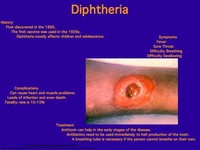Facts about Diphtheria

Between 1990 and 1998, the countries of the former Soviet Union reported more than 150,000 cases and 5,000 deaths, which represented more than 80 percent of diphtheria cases reported globally (Dittmann 2000).

According to CDC guidelines, cases of cutaneous diphtheria should not be reported, while cases of the disease caused by nontoxigenic C. diphtheriae should be reported as diphtheria.

Diphtheria can also cause paralysis in the eye, neck, throat, or respiratory muscles.

Princess Alice of Hesse (second daughter of Queen Victoria) died of diphtheria after she contracted it from her children in December of 1878 while nursing them.

In 1883, the bacterium that causes diphtheria, Corynebacterium diphtheriae, was first described, by Theodor Klebs.

Diphtheria is spread by direct physical contact or breathing the secretions of those infected.

Diphtheria was once quite common, but has largely been eradicated in developed nations.

One of Princess Alice's daughters, Princess Marie, also died of diphtheria in November of 1878.

Individuals with severe cases are put in a hospital intensive care unit (ICU) and given a diphtheria antitoxin.

Diphtheria was once one of the most dreaded diseases, with frequent large-scale outbreaks.

Signs of cutaneous diphtheria infection develop an average of seven days after the appearance of the primary skin disease.

Diphtheria was also prevalent in the British royal family during the late nineteenth century.

After the breakup of the former Soviet Union in the late 1980s, vaccination rates in its constituent countries fell so low that there was an explosion of diphtheria cases.

Research has shown that antibiotics do not promote healing of local infection in diphtheria patients treated with antitoxin.

The test was invented by Hungarian-born American pediatrician Bйla Schick (1877-1967) in the early twentieth century to determine whether a person is susceptible to diphtheria.

Diphtheria remains a serious disease, with fatality rates between five and 10 percent in adults.

In 1884, Friedrich Loffler isolated C. diptheriae and injected it into various animals, proving that it was the agent that caused diphtheria.

A diphtheria epidemic in the New England colonies between 1735 and 1740 was said to have killed as many as 80 percent of the children under ten years of age in some towns.

Longer-term effects of the diphtheria toxin include cardiomyopathy (deterioration of the function of the heart muscle) and peripheral neuropathy (damage to nerves of the peripheral nervous system).

Instead, antibiotics are given to individuals suffering from the disease, or carriers, to eradicate the bacterium C. diphtheriae and prevent its transmission to other people.

Diphtheria takes its name from the Greek word for “leather,” ??????? (dipthera), and was named in 1826 by French physician Pierre Bretonneau.

The current definition of diphtheria used by the U. S. Centers for Disease Control and Prevention (CDC) is based on both laboratory and clinical criteria.

The agency also recommends that all diphtheria isolates be sent to the CDC's diphtheria laboratory.

The cutaneous form of diphtheria affects the skin and is often a secondary infection of a preexisting skin disease.



